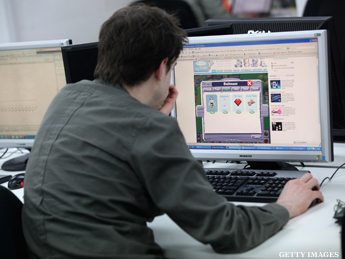
Are you hunched over your computer right now? Then it's time to get up and move around, even if it's for a minute. Because whether it seems like it or not, small changes to your daily routine at work or desk can make a lasting impact on your overall healthy and fitness.
"Would you rather endure 90 seconds of pain or 90 years of pain?" Austin, Texas-based fitness trainer Brant Hatton says. "It's something I hear as a motivational tool in Bikram Yoga, and while it seems sort of silly, it's true."
Making a conscious effort to make small tweaks to the hours of your workday will not only improve your health, but also preserve the success you’ve already had at the gym. Here are three simple steps from Hatton to keep your workday from wrecking your health for years.
1) Stay on your feet as much as possible
"It doesn't matter how or when," Hatton says. "Conference calls, waiting for computers load, sitting on hold, etc. -- they can all be turned into cues for you to get on your feet and move around. Any chance you get to stand up and move around, you should take it."
That could also mean walking to lunch instead of driving, or walking down the hallway to deliver a message you'd normally email. Not only does it wake your muscles up from their sedentary state, but also mixes up your heart rate.
2) Posture, posture, posture
Hatton says the No. 1 issues with all of his clients that work at desks all day is something called Upper Crossed Syndrome. Put simply, it's the tendency for your head to protrude forward along with your shoulders. The effect is unaffectionately called "turtle neck," and it doesn't look good on anyone. It also is terrible for your health.
"It can take us three weeks in training sessions to correct, and then it takes constant attention to maintain," Hatton says.
You can avoid that fate without much physical effort and a little mental training.
"If the company offers some sort of ergonomic setup, go for it. Elevate your keyboard or get a better chair," Hatton says. "The key to good posture is being aware of what it is. Ears directly over your shoulders, make sure you're sitting upright, get a chair with a higher back so that you can feel your shoulders against the back of the chair.
"The reality is your work is going to make you slip into bad posture. We all naturally lurch toward screens, keyboards, notebooks and reading materials. The trick is noticing when you do it and simply leaning back correctly."
3) Stretch and use resistance bands/light weights for quick moves
One of the great pitfalls of being stationary all day is that your muscles tend to tighten up. Keeping them loose, and finding ways to use them actively in short bursts can pay huge long-term dividends.
A lot of people think sitting on an exercise ball will make a difference, but it's not that simple. It can even been counterproductive, according to Hatton. Instead, give yourself reasons to reach up or down and get off your butt.
"Keep surgical tubing or resistance bands hanging from a door or cubicle wall, or maybe have three-pound dumbbells by your desk," Hatton says. "They're great visual cues to remind you to move around and do some light stretching or lifts, and when you use them, they help counter the small movements that don’t do much good for you over the day, like moving a mouse or typing."
It will also help promote circulation and flexibility, keeping your body in a state of readiness for activity, and making those trips to the gym or jogs around the neighborhood easier to jump into.
Whatever you do, do it often. It may seem like you don’t have time, but you do. Even if you don't have 90 seconds, you have 30 seconds here and there. And it’s a relative mental rationale, Hatton says.
"Would you rather endure 30 seconds of minimal pain and effort, or 30 years of an aching back and neck?"
Popular Stories On ThePostGame:
-- Ex-Marine Sets Record In Endurance Planking
-- The 15-Minute Hotel Room Workout
-- U.S. Olympic Legend Makes Surprising Endorsement
-- Blue Is The New Green: Next-Generation Athletic Wear May Be Fully Compostable




